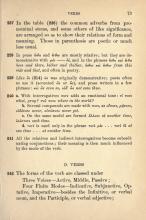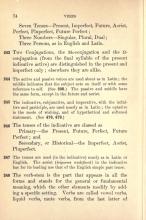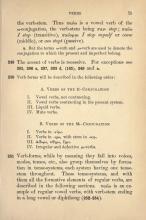242. The forms of the verb are classed under the following categories.
Voice: Active, Middle, Passive
Mood: Indicative, Subjunctive, Optative, Imperative—besides the Infinitive, or verbal noun, and the Participle, or verbal adjective
Tense: Present, Imperfect, Future, Aorist, Perfect, Pluperfect, Future Perfect
Number: Singular, Plural, Dual
Person: as in English and Latin
243. Two Conjugations, the μι-conjugation and the ο-conjugation (from the final syllable of the present indicative active) are distinguished in the present and imperfect only; elsewhere they are alike.
244. The active and passive voices are used about as in Latin; the middle indicates that the subject acts on itself or with some reference to self. (See § 500.) The passive and middle have the same form, except in the future and aorist.
245. The indicative, subjunctive, and imperative, with the infinitive and participle, are used nearly as in Latin; the optative is the mode of wishing, and of hypothetical and softened statement. (See §§ 476, 479.)
246. The tenses of the indicative are classed as follows.
Primary: the Present, Future, Perfect, Future Perfect
Secondary or Historical: the Imperfect, Aorist, Pluperfect
247.The tenses are used (in the indicative) nearly as in Latin or English. The aorist (ἀ-όριστος undefined) in the indicative has for its leading use that of the English simple past tense.
248. The verb stem is the part that appears in all the forms and stands for the general or fundamental meaning, which the other elements modify by adding a specific setting. Verbs are called vowel verbs, liquid verbs, mute verbs, from the last letter of the verb-stem. Thus παύω is a vowel verb of the ω-conjugation, the verb-stem being παυ- stop.
παύω I stop (transitive)
παύομαι I stop myself or cease (middle)
I am stopped (passive)
a. But the terms ω-verb and μι-verb are used to denote the conjugation to which the present and imperfect belong.
249. The accent of verbs is recessive. For exceptions see §§ 285, 296.a, 297, 300.d, (165), 349 and 349.a.
250. Verb forms will be described in the following order.
A. VERBS OF THE Ο-CONJUGATION
I. Vowel verbs, not contracting
II. Vowel verbs contracting in the present system
III. Liquid verbs
IV. Mute verbs
B. VERBS OF THE Mι-CONJUGATION
I. Verbs in -νῡμι
II. Verbs in -ημι, with stem in -α:η-
III. Δίδωμι, τίθημι, ῑ̔́ημι
IV. Irregular and defective μι-verbs
251. Verb forms, while by meaning they fall into voices, modes, tenses, etc., also group themselves by formation in tense-systems, each system having one tense-stem throughout. These tense systems, and with them all the formative elements of regular verbs, are described in the following sections. παύω is an example of regular vowel verbs, with verb stem ending in a long vowel or diphthong (§§ 252 – 254).



